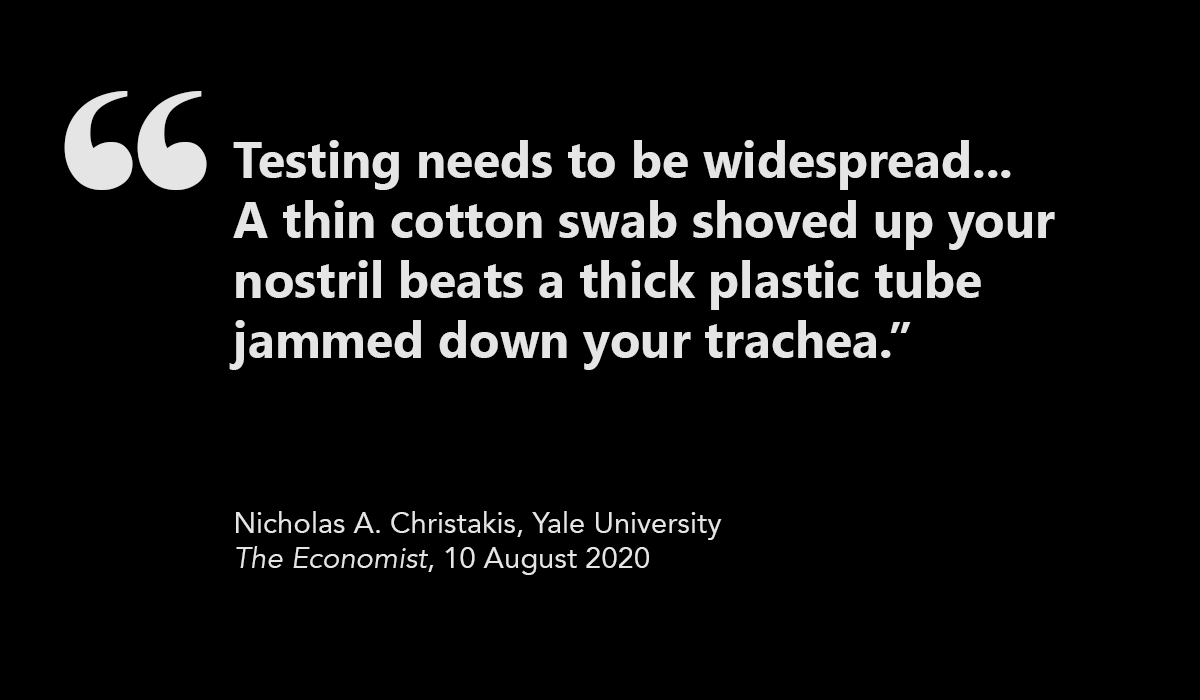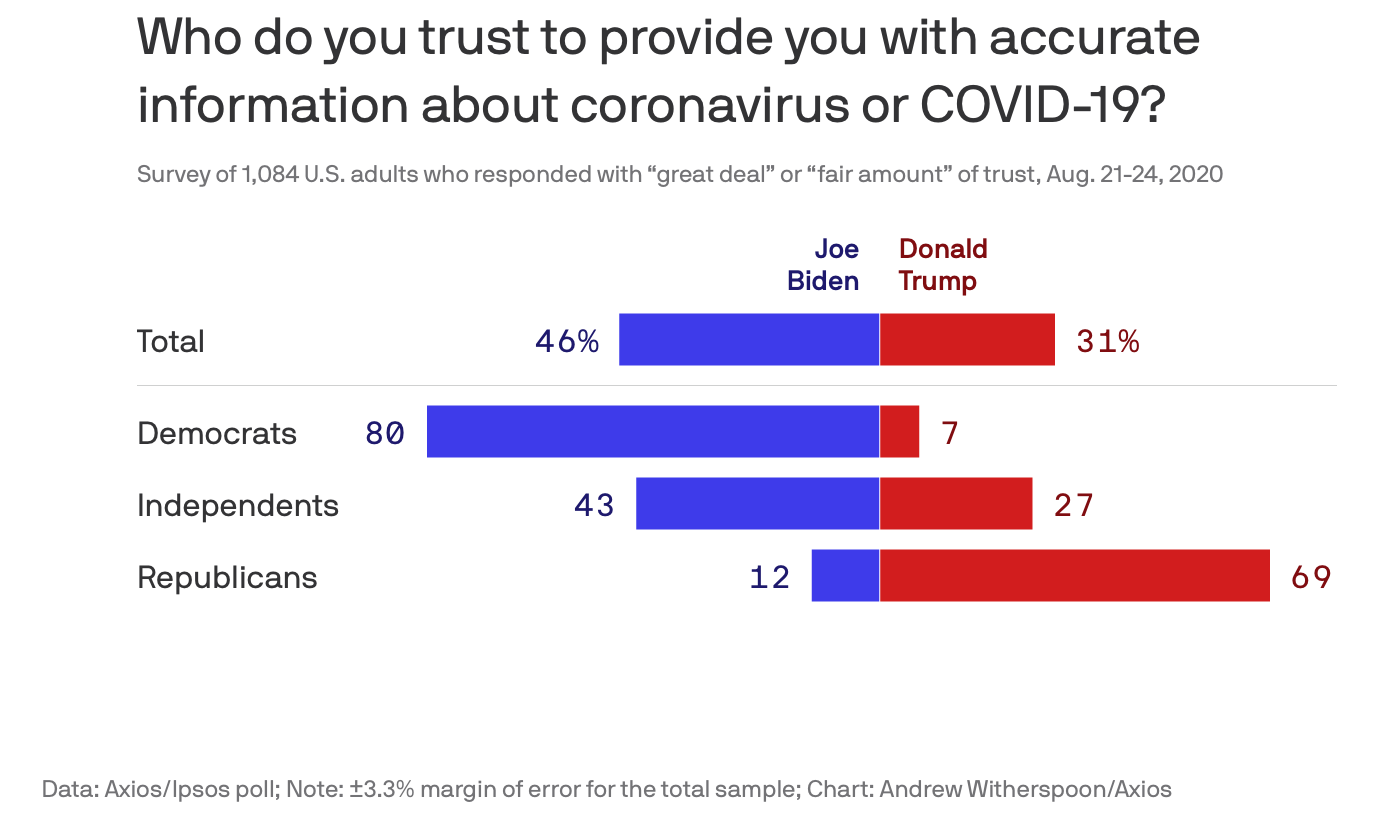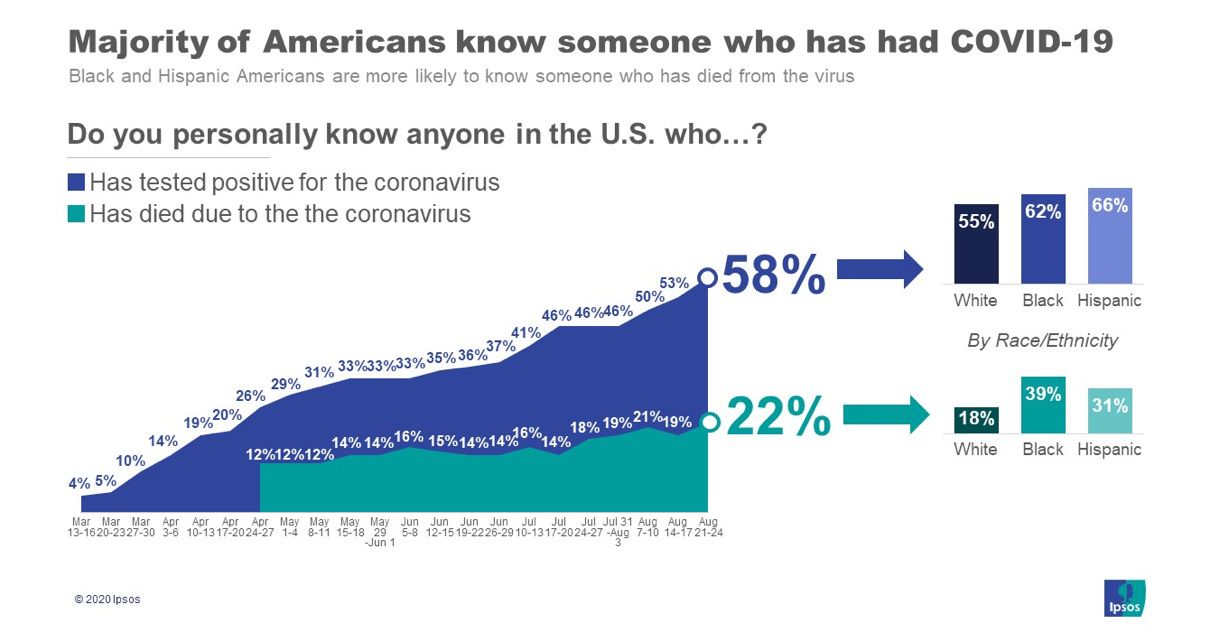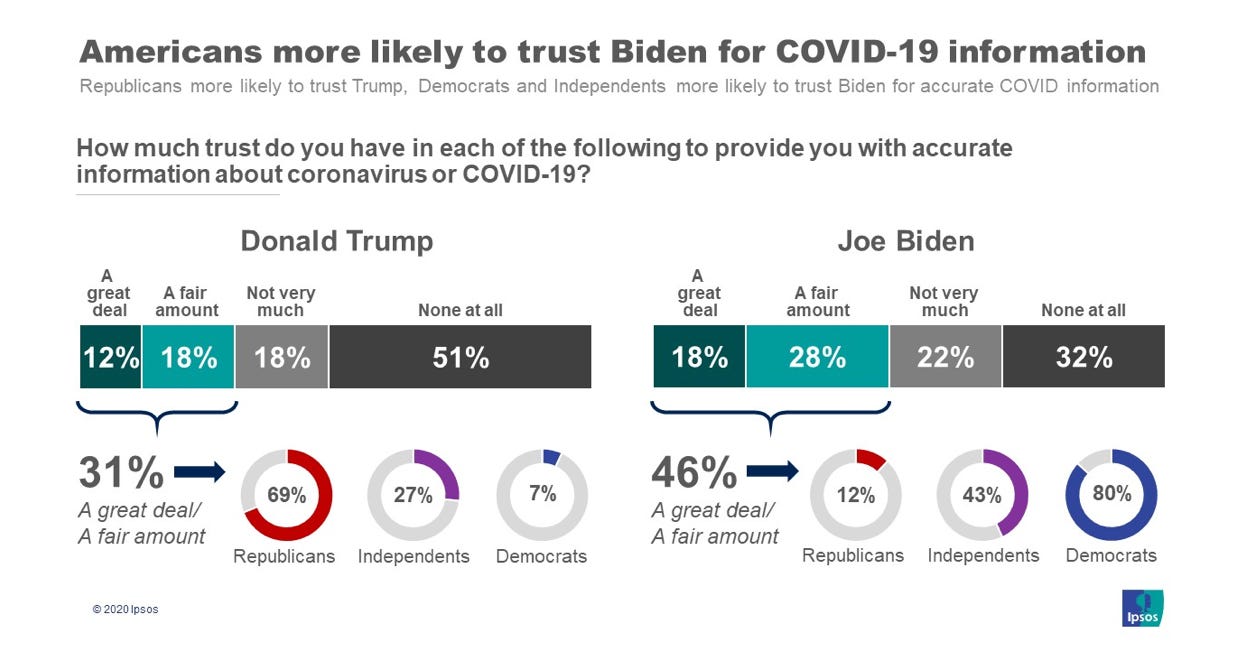COVID-19 day 218: 📈 FDA chief "mea culpa" illustrates our ongoing problem with politicized "science" : 25 August 2020
3-in-5 Americans know someone who has tested positive, 1-in-5 who has died; Hong Kong researchers say 33 year-old-man has been re-infected; is Trump going to fast-track a vaccine before Nov?

Monday was day 217 since the first case of coronavirus disease was announced in the United States. Today, I am comparing weekend data with Friday’s report.
About that quote: Nicholas A. Christakis has written Apollo’s Arrow: The Profound and Enduring Impact of Coronavirus on the Way We Live, which is slated to be published in October. More below in recommended reading.
Sections (no jump links, sorry!)
1, One big thing; 2, Recommendations; 3, Politics, economics & COVID; 4, Key metrics;
5, Resources
⓵ One big thing - Governing in the age of COVID-19
According to Gallup, 41% of Americans claim no party affiliation, 31% identify as Democrats and 26% identify as Republicans. As both parties end the month with nominating conventions, it’s important to understand that 2-in-5 have no dog in the hunt.
If you had any doubt about how politicized public policy has become, look at this sobering chart from Axios.

When I see these data, I wonder if the only people who are getting sick are Democrats and independents. Because 3-in-5 Americans know someone who has tested positive, and 1-in-5, someone who has died.

There are two other sobering details from the Axios/Ipsos poll:
Skepticism is rampant: 28% of those surveyed do not trust what either Biden or Trump say about the coronavirus.
The animus towards Trump is deep seated: 51% do not trust anything Trump says about COVID-19. A non-trivial 32% feels the same way about Biden.

Independent voters can swing an election when partisans fail to turn out in force. But independent voters have no formal voice. There is only one independent-when-it-suits-him Senator, Bernie Sanders. With the Presidency, Senate and House being driven by hyper-partisanship, governing in 2021 will be no cakewalk.
PRESIDENT TRUMP ANNOUNCED a “new” treatment for Covid-19 on Sunday, just in time for the start of the Republican National Convention.
As an illustration of how partisanship can poison, look no further than Sunday’s FDA announcement that the FDA issued a fast-track (emergency use) authorization to use plasma from those who have recovered from COVID-19 to treat current patients.
At a news conference on Sunday announcing the emergency approval of blood plasma for hospitalized Covid-19 patients, President Trump and two of his top health officials cited the same statistic: that the treatment had reduced deaths by 35 percent…
But scientists were taken aback by the way the administration framed this data, which appeared to have been calculated based on a small subgroup of hospitalized Covid-19 patients in a Mayo Clinic study: those who were under 80 years old, not on ventilators and received plasma known to contain high levels of virus-fighting antibodies within three days of diagnosis.
What’s more, many experts — including a scientist who worked on the Mayo Clinic study — were bewildered about where the statistic came from. The number was not mentioned in the official authorization letter issued by the agency, nor was it in a 17-page memo written by F.D.A. scientists. It was not in an analysis conducted by the Mayo Clinic that has been frequently cited by the administration.
And Monday evening, FDA Commissioner Stephen Hahn tweeted: “The criticism is entirely justified.”
NPR dissects the criticism (and the math), concluding that mortality apparently improved 3-5%. That’s a far cry from the 35% that Hahn and Trump touted Sunday.
Adding to the political complexion of this incident, the FDA's press release on Sunday strayed from the usual just-the-facts explanation and included in a headline that the authorization is "Another Achievement in Administration's Fight Against Pandemic."
And this is not the first time Hahn has exaggerated to make political hay.
Hahn has previously mischaracterized scientific findings to support Trump administration talking points. In March, he touted a study out of China that he told NPR's Morning Edition showed coronavirus tests developed in that country were of poor quality. In fact, as NPR reported, he misrepresented the paper's findings, based on a cryptically worded scientific abstract that summarized the paper. The actual research had in fact already been retracted.
Remember the FDA emergency use authorization for Chloroquine and Hydroxychloroquine, the controversial treatment promoted by Trump and a gaggle of non-scientists in the White House? March 28, 2020 authorization and June 15 revocation.
It’s not just FDA.


The reasons behind the surprise shift in testing recommendations are unclear. In response to an inquiry from The New York Times, a representative for the C.D.C. directed the questions to the U.S. Department of Health and Human Services (emphasis added).
Is it any wonder that a significant percentage of Americans have thrown up their hands with a “pox on both their houses” attitude?
It is incumbent upon us to advocate loudly, repeatedly, for getting politics out of scientific decisions. Certainly, COVID is not the first place that the boundaries have blurred: see environmental regulation and the war on fat.
This pandemic is a global health threat unlike anything we have seen in a century. There is no room for petty politics. As Hilda Bastian writes in Wired, we have to be able to trust how upcoming decisions will made regarding vaccines, and the track record right now is lousy. “If we can’t trust how [vaccines] are made and communicated, the consequences will be dire.”
⓶ Recommendations
🤓 Recommended reading
If you have not done so, give The Economist an email address so you can read a few articles free each month. If you read nothing else about COVID-19 this week, you should read this.
SEVEN VARIETIES of coronavirus infect humans: four give us the sniffles; one causes a deadly disease smouldering in the Middle East since 2012; and two erupted into full-on pandemics. The first caused SARS and it petered out quickly. The other causes covid-19 and it has hobbled the global economy. Why the difference?
[…]
Now imagine a second pathogen that again makes 20 seriously ill and kills two for every 1,000 people, but also infects a further 180 people making them mildly or moderately ill, but not killing them. Perhaps some of them are left seriously disabled, too. But the case fatality rate gets calculated as two deaths out of 200, for a mere 1%. The second disease seems much milder. In reality it is far worse: no one would prefer to be in a group facing the second pathogen rather than the first—with ten times as many people infected.
Nicholas Christakis on fighting covid-19 by truly understanding the virus. The Economist, 10 August 2020.
🔬 Research and medical news
There have been anecdotes about people who got re-infected with SARS-CoV-2 but, until now, no scientific evidence. In this case of a 33-year-old man, University of Hong Kong researchers sequenced two virus samples and found that 24 nucleotides (the ‘letters’ that make up the RNA) were different between his late March and August infections.
What this might mean for immunity, no one knows.
…experts knew that immunity to SARS-CoV-2 would not last forever. People generally become susceptible again to the coronaviruses that cause the common cold after a year or even less, while protection against SARS-1 and MERS appears to last for a few years.
First Covid-19 reinfection documented in Hong Kong, researchers say. STAT News, 25 August 2020.
Wealthy countries have struck deals to buy more than two billion doses of coronavirus vaccine in a scramble that could leave limited supplies in the coming year. Meanwhile, an international effort to acquire vaccines for low- and middle-income countries is struggling to gain traction… The rush is dispiriting for public-health experts who have urged that vaccines be equitably distributed across the world.
The unequal scramble for coronavirus vaccines. Nature, 24 August 2020.
⓷ Politics, economics and COVID-19
❌ The University of Alabama has reported more 560 COVID-19 cases since classes resumed. The University of Kansas reported more than 80 cases last week. Yet the University of Southern California calls 43 cases “alarming.”
‼️ In Camden County, Georgia, the school district “has refused to publicly confirm a single case, either to the local community or The New York Times” despite widespread word of mouth within the community.
🥩 Texas officials claim local health orders do not apply to private religious schools.
💉 The Financial Times reported that the Trump Administration is exploring fast-tracking a UK vaccine before November (for obvious reasons). However, the UK firm which is working with Oxford University on a vaccine told The Guardian that it is not in talks with Trump. “One of the potential dangers if you prematurely let a vaccine out is that it would make it difficult, if not impossible, for the other vaccines to enroll people in their trial,” Dr. Anthony Fauci told Reuters.
⓸ Key metrics
Only 11 states have positivity rates of less than 5%, which is the WHO threshold for beginning to re-open an economy. Those are Vermont, Alaska, Maine, West Virginia, Montana, New Mexico, New Hampshire, Hawaii, Michigan, Oregon and Connecticut.
Nine states have positivity rates of more than 10%, which is the US threshold for beginning to re-open. Those are Nevada, Georgia, Texas, Idaho, South Carolina, Alabama, Florida, Mississippi and Arizona. These states should be testing more.
🦠 Monday, Johns Hopkins reported 5,739,724 (117,184 new) cases and 177,252 (1,889 new) deaths since Friday. That’s a decline in daily cases, from 49K cases on Friday to a three-day average of 39K. The decline in reported deaths is similar, from 1,108 on Friday to a three-day average of 630. This is normal, however, for the Sa-Su-Mo reporting period.
Monday
- seven-day average: 42,064 cases and 900 deaths
- 3.09 % cases leading to death
- case rate, 173.4 per 10,000; death rate, 5.4 per 10,000One week ago
- seven-day average: 49,183 cases and 945 deaths
- 3.14% cases leading to death
- case rate, 164.3 per 10,000; death rate, 5.2 per 10,000
Note: the seven-day average is important because dailies vary due to factors other than actual case numbers, particularly over a weekend.
🇺🇸 24 August
CDC: 5,682,491 (38,679 new) cases & 176,223 (572 new) deaths
- One week ago: 5,382,125 (41,893 new) cases & 169,350 (654 new) deathsState data*: 5,713,293 (35,202 new) cases & 169,208 (350 new) deaths
- One week ago: 5,417,366 (37,817 new) cases & 162,400 (407 new) deaths
KS reports only M-W-F; CT and RI report only M-FWHO: 5,612,163 (44,946 new) cases & 175,243 (997) deaths
- One week ago: 5,382,125 (41,893 new) cases and & 169,350 (654 new) deaths
🌎 24 August
Johns Hopkins interactive dashboard (11.00 pm Pacific)
Global: 23,647,377 (226,959 new) cases & 813,022 (4,346 new) deaths
- One week ago: 21,881,858 (209,672 new) cases & 774,034 (-1,210 new) deaths
* Johns Hopkins data, ~11.00 pm Pacific.
State data include DC, Guam, the Northern Mariana Islands, Puerto Rico and the US Virgin Islands
The virus was not created in a lab and the weight of evidence is that it was not released intentionally. Although early reports tied the outbreak to a market in Wuhan, China, analyses of genomic data have suggested that the virusdeveloped elsewhere.
⓹ Resources
👓 See COVID-19 resource collection at WiredPen.
📝 Subscribe to Kathy’s COVID-19 Memo :: COVID-19 Memo archives
🦠 COVID-19 @ WiredPen.com
📊 Visualizations: US, World
🌐 Global news (at WiredPen)



